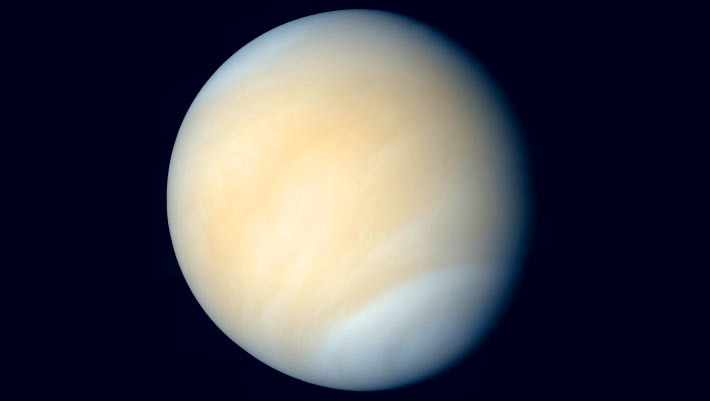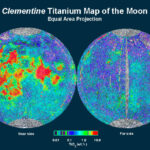The clouds of Venus are believed to be composed of sulfuric acid and minor constituents including iron-bearing compounds. Respective concentrations of these compounds vary with height in the thick atmosphere of our neighboring planet. In a new study, researchers at the University of Cambridge synthesized iron-bearing sulfate minerals that are stable under the harsh chemical conditions in the Venusian clouds. Their spectroscopic analysis revealed that a combination of two minerals, rhomboclase and acid ferric sulfate, can explain the mysterious ultraviolet (UV) absorption feature in the Venusian atmosphere.
Jiang et al. hypothesize a rich and largely unexplored heterogeneous chemistry in the cloud droplets of Venus that has a large effect on the optical properties of the clouds and the behavior of trace gas species throughout Venusian atmosphere. Image credit: Mattias Malmer / NASA.
The clouds of Venus hold several mysteries. They extend from 48 km to roughly 65 km and provide a transition region between the lower atmosphere (<48 km) that is dominated by thermochemistry and dynamics and the upper atmosphere (>65 km), for which photochemistry and dynamics are relevant.
To understand the chemical cycles between the Venusian atmosphere and its volcanic surface, and to correctly interpret potential biosignatures, an increasing research effort has been dedicated to generating a complete model framework of Venusian atmosphere.
“The only available data for the composition of the clouds were collected by probes and revealed strange properties of the clouds that so far we have been unable to fully explain,” said Dr. Paul Rimmer, a researcher with Cavendish Laboratory at the University of Cambridge.
“In particular, when examined under UV light, the Venusian clouds featured a specific UV absorption pattern.”
“What elements, compounds, or minerals are responsible for such observation?”
Formulated on the basis of Venusian atmospheric chemistry, Dr. Rimmer and colleagues synthesized several iron-bearing sulfate minerals in an aqueous geochemistry lab.
By suspending the synthesized materials in varying concentrations of sulfuric acid and monitor the chemical and mineralogical changes, they narrowed down the candidate minerals to rhomboclase and acid ferric sulfate, of which the spectroscopic features were examined under light sources specifically designed to mimic the spectrum of solar flares.
In an attempt to mimic the even more extreme Venusian clouds, the authors measured the UV absorbance patterns of ferric sulfate under extreme acidic conditions.
“The patterns and level of absorption shown by the combination of these two mineral phases are consistent with the dark UV-patches observed in Venusian clouds,” said Dr. Clancy Zhijian Jiang, a researcher at the University of Cambridge.
“These targeted experiments revealed the intricate chemical network within the atmosphere, and shed light on the elemental cycling on the Venusian surface.”
“Venus is our nearest neighbor, but it remains a mystery,” Dr. Rimmer said.
“We will have a chance to learn much more about this planet in the coming years with future NASA and ESA missions set to explore its atmosphere, clouds and surface.”
“This study prepares the grounds for these future explorations.”
The team’s paper appears in the journal Science Advances.
_____
Clancy Zhijian Jiang et al. 2024. Iron-sulfur chemistry can explain the ultraviolet absorber in the clouds of Venus. Science Advances 10 (1); doi: 10.1126/sciadv.adg8826




